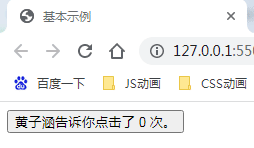基本示例
这里有一个 Vue 组件的示例:
// 定义一个名为 button-counter 的新组件
Vue.component('button-counter', {
data: function () {
return {
count: 0
}
},
template: '<button v-on:click="count++">You clicked me {{ count }} times.</button>'
})
组件是可复用的 Vue 实例,且带有一个名字:在这个例子中是
<button-counter>。我们可以在一个通过new Vue创建的 Vue 根实例中,把这个组件作为自定义元素来使用:
<div id="components-demo">
<button-counter></button-counter>
</div>
new Vue({ el: '#components-demo' })
<!DOCTYPE html>
<html lang="zh">
<head>
<meta charset="UTF-8">
<meta http-equiv="X-UA-Compatible" content="IE=edge">
<meta name="viewport" content="width=device-width, initial-scale=1.0">
<title>基本示例</title>
<script src="./vue.js"></script>
</head>
<body>
<div id="components-demo">
<button-counter></button-counter>
</div>
<script>
Vue.component('button-counter', {
data: function () {
return {
count: 0
}
},
template: '<button v-on:click="count++">黄子涵告诉你点击了 {{ count }} 次。</button>'
})
var VM = new Vue({
el: '#components-demo'
})
</script>
</body>
</html>

因为组件是可复用的 Vue 实例,所以它们与
new Vue接收相同的选项,例如data、computed、watch、methods以及生命周期钩子等。仅有的例外是像el这样根实例特有的选项。

